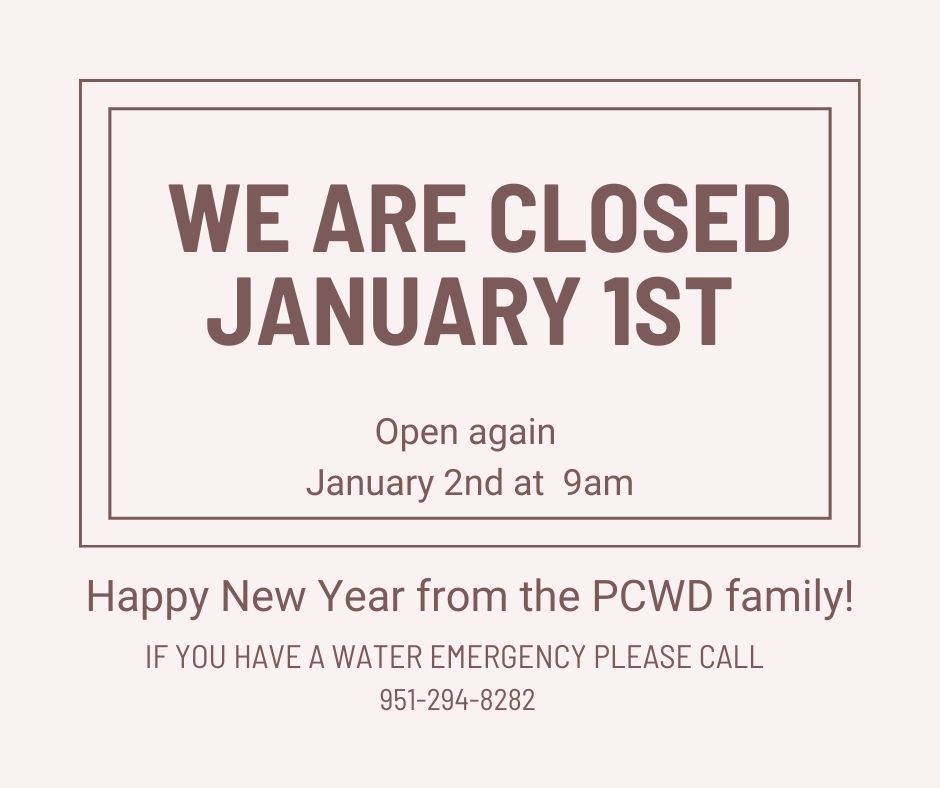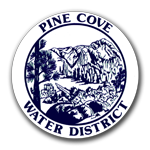Daylight Savings Time

Uncategorized
Archive for Uncategorized

There is something about Spring that brings a whole new, vibrant energy! As springtime brings more sun back, it is important to be mindful of our water use during warmer weather. Experts estimate that roughly 50% of our water that is used outdoors is wasted through evaporation or runoff that is caused by overwatering. Being mindful of the amount of water we use can not only help prevent water shortages during drought season, but it can also help reduce the cost of your water bill.
Here are a few tips to help you keep your water usage down during the warmer months.

Pine Cove Water District will be closed Monday February 17, 2025 in observation of Presidents Day.
We will be back open the following day, Tuesday February 18, 2025 at 9am to assist with any questions or needs. In the meantime, if you have a water emergency please contact our after hours number at
(951) 294-8282
Weather:
This coming weekend there is a chance of Rain/Snow on Sunday and early Monday morning. Prevent leaks and broken pipes by turning your water off at your customer valve, located next to the meter at the street, whenever you leave your mountain home. If you do not know where your customer valve is or how to turn it off, please give us a call during normal business hours 9 am – 4 pm Monday – Friday and we will send someone over to help you locate your valve and show you how to turn it off and on.
Sand Bags:
We have free sandbags available to our customers here in the front office!!! If you come during normal business hours, we have sand and a sand scoop you are welcome to use.
If you have any questions please do not hesitate to call or stop by the office. 24917 Marion Ridge Road (next door to the fire department). 951-659-2675
We Are Closed for MLK Jr. Day
In honor of Martin Luther King Jr. Day, we will be closed on Monday, January 20th. We encourage everyone to take time to reflect on his legacy and commitment to equality and justice.
We will resume regular hours on Tuesday, January 21st
Thank you for your understanding!
Attention all Pine Cove Water District Customers, when you are out walking in your neighborhood or outside in your yard please listen, if you hear water leaking we offer a $25.00 Gift Certificate to a restaurant of your choice in Idyllwild.
LOOK LISTEN CALL!!
If you see or hear water running, be the 1st to call it in, and you can earn a $25.00 reward, to a restaurant of your choice in Idyllwild.
Office: 951-659-2675
After Hours: 951-294-8282
The Pine Cove Water District needs your help!
Our water demand is at least twice the amount it should be during the Winter months. Why? Because some customers do not shut their water off when they leave Pine Cove. Did you shut your water off at your customer valve when you left your mountain home? Do you need us to shut your water off for a $15.00 service fee? Please call our office if you have any questions or concerns at 951-659-2675.
Thank you for your help!!

Posted in: Uncategorized
Leave a Comment (0) →Christmas is almost upon us! We will be closing early December 24th at 12pm. We will also be closed on Christmas Day and the day after, December 25 & 26th. We will resume normal business hours on Friday, December 27th. Our normal business hours are from 9 am until 4 pm.
We do have someone on call 24 hours a day, should a water emergency occur.
That number is 951-294-8282, but remember, this number is for emergencies only.
Jeremy Potter, Jennifer Hayes, Kaley Chapman, Jensen Beri, Dan Arson, & Mouse the dog.
Static is the buildup of an electrical charge on the surface of another object. As the charge moves from one object to another, it releases electricity, producing a shock. It is directly affected by humidity. Static increases when the air gets cold and humidity drops. To stay warm in your home, you turn up the heat, further adding to a decrease in humidity and increasing static. While static can be annoying and sometimes painful, there are some simple things you can do to reduce it.
Probably the most important tip is to add water back to the air circulating in your home. This can be done in a few ways. First, a humidifier can be used to produce a continuous stream of moisture. This can be a unit placed in the room you are in or a humidification unit added to your home’s heater.
If you don’t have a humidifier, you can place a pot of water on the stove and let it evaporate, adding moisture to the air. This can be particularly nice if you also add things that smell good – like evergreen sprigs or a drop or two of essential oils like lavender. Just be sure not to let the pot get dry. It’s a good idea to set an alarm so you can move freely away from the stove.
Another major source of static electricity is fabric – whether it is your clothing, your upholstery, or your carpet. Dryer sheets can go a long way to reduce static in these instances. While you can’t get your furniture in your dryer, you can rub a dryer sheet over the surface of the upholstery.
For your carpet, you can either use liquid fabric softener or static elimination sprays. If you use liquid fabric softener, dilute with water and spray just a little on the carpet – you don’t need to soak the surface to get a good result.
For reducing static in your clothing, try wearing natural fabrics, such as cotton. Anything synthetic will build up a charge faster, and therefore create the shock when you touch something.
To stop the dreaded shock when touching the doorknob – touch it with something metal first, essentially grounding yourself. This can be a key, a thimble, or a safety pin that you keep with you for just this purpose.
And finally, keeping your floors tidy and clean through vacuuming, sweeping, and mopping can also help reduce static electricity by reducing the amount of dust. The Cleaning Authority is here to help with that – get an estimate today.
Pine Cove Water District
24917 Marion Ridge Road • P.O. Box 2296 • Idyllwild CA 92549-2296 • 951.659.2675
